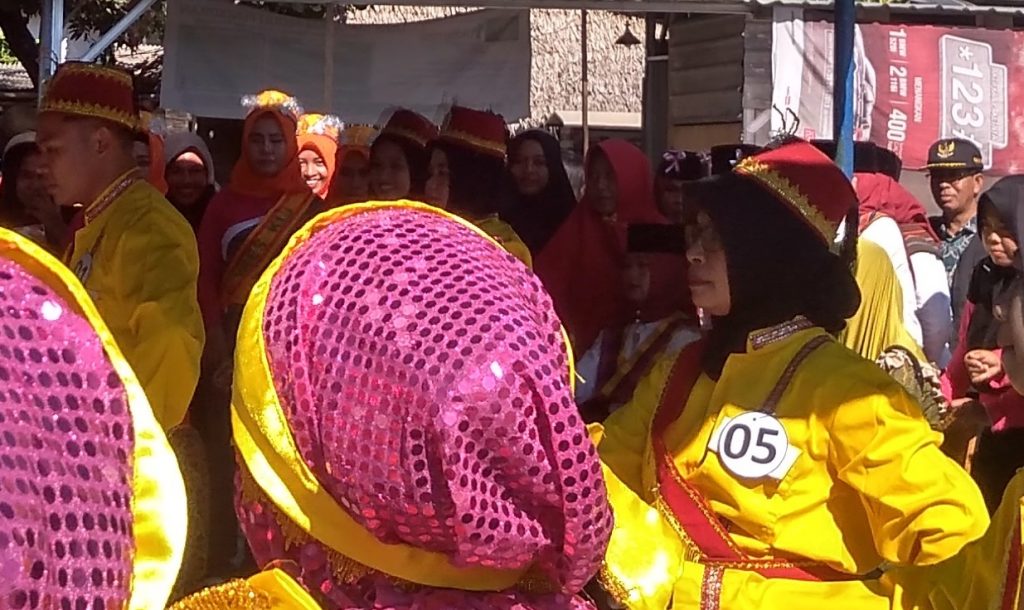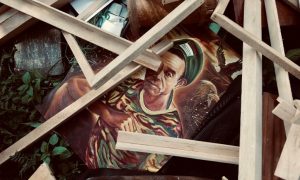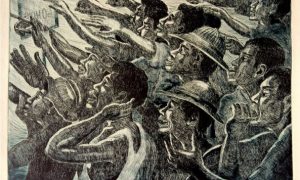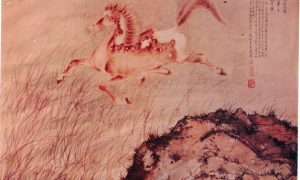In July 2018, an earthquake struck Lombok island, leaving North Lombok heavily damaged. During that time, I was in touch with a local art collective called Komunitas Pasir Putih, which operated in a badly affected neighbourhood, and they told me that they had initiated a project called Art Quake in response. It included many artistic activities: mini-concerts, movie screenings, and video and drawing workshops.
I was intrigued to explore how Pasir Putih as a community is transforming itself in response to the disaster situation. According to Oka one of Pasir Putih artists, Pasir Putih had not experienced major earthquakes nor about humanitarian reliefs before the 2018 earthquake struck. A year after the earthquake, Pasir Putih’s activities were all in response to the problems in North Lombok in a post-disaster context. I spent four weeks observing the Pasir Putih camp, in the Pemenang district in June 2019. In this article, I will focus on Pasir Putih’s use of art as a medium to raise women’s empowerment in a post-disaster situation, and the personal experience of Martini Supiana, or Ana.
Ana is a performer from West Pemenang village. Before marrying Gazali (director of Pasir Putih), Ana lived with her parents in the Bayan district, a one-hour drive from Pemenang. I mentioned her as “a performer” in this story, but it is a simplification. Ana does many other things in Pasir Putih other than just artistic work. “I am a theatre performer, rudat instructor, farmer, crafter, and play-group teacher.” She spends the first half of the day in school and teaches rudat, a traditional dance that is well known in many different parts of Indonesia, including Bali, West Nusa Tenggara, West Java, and Lampung, in different places afterward. Ana was involved in a lot of rudat rehearsals, preparing several teams to attend a competition when I was in Pasir Putih. Once a week, she also organized a routine class for rudat. Through Ana’s story, we can see rudat as a collective art performance can be moulded into different functions: from trauma healing activities post-earthquake to raising women’s participation in performing arts.
Rudat is adapted from a komidi-rudat theatrical performance, “featuring Arabian and Persian soldiers,” and a male group martial arts from Muslim tradition. In Lombok, rudat transformed into a more secular form, while the Muslim theatrical aspect disappeared from the performance.
Some of Pasir Putih’s artists, including Ana, told me that rudat is strongly related to Dutch and Japanese colonial history in Indonesia. However, Pasir Putih, as an art community in Lombok, has adapted rudat into a more contemporary form, called senam rudat (rudat aerobics). As Ana put it, Pasir Putih tried to “make rudat viral again,” after the earthquake a year before. Gazali, as the director of Pasir Putih, was invited to join a trauma healing project meeting by the Ministry of Education and he suggested rudat to be a collective performance activity for earthquake victims. “My husband suggested it to the forum, and he asked someone from a dance community here to help us in modifying the movements.” Senam rudat became a regular activity in Pemenang from February 2019, and the activity became a part of the Artquake program August 2019 and a month after.
To get to know Ana’s perspectives and experiences of senam rudat as a woman artist, I joined her in some senam rudat exercises and one competition. I found out that senam rudat as a contemporary performance contributes to the reproduction of gendered social relations. The first time I tried to get involved with senam rudat was on my second day in the Pasir Putih community, and I learned that most of the participants are women from Pemenang district. Some male Pasir Putih artists encouraged me to join the senam rudat exercise in the evening, but they did not get involved themselves—they just sat around and chatted with each other. Ana was the instructor, standing in front of the group and giving instructions on how the movements should be done.
Later I discovered that senam rudat, or senam in general, is associated with ibu-ibu (middle-aged women). Most of the women are part of Perempuan Pemenang group, a small community for women in West Pemenang village that is also part of Pasir Putih community. Ana is also a leader of Perempuan Pemenang. Jaka, a leader of the dance community in the Pemenang sub-district, is usually acknowledged as the person who shaped rudat into a more contemporary form.
Rudat as a traditional performance is usually performed by male artists. Ana told me that the first time (February 2019) the Pasir Putih community performed rudat at the Bangsal Menggawe festival, held annually by the Pasir Putih Community, the participants were male. Ana invited ibu-ibu in Pemenang to join the performance. “They were shy and hesitant to join the performance at that time in the harbour. I joined the performance and invited them. Knowing that more women were joining the performance, other women in the village also wanted to join.” Ana teaches rudat almost every day of the week because, as she told me when we had lunch together at her house, she taught different groups of women, not only in Pemenang village but also in other parts of North Lombok.
Ana also noticed that women in Pemenang like to do aerobics in their leisure time, and some of them were involved in common aerobic activities from other countries such as zumba. She used this as a chance to introduce an alternative performance from their local culture. For Ana, the most important thing is that rudat becomes popular and women are proud to be in the performance. As she said, “I want that people here can also be proud that they have senam rudat, not only senam dari luar (aerobics from other countries) and teach it to their children. Because who else can do it?”. The adaptation of rudat into its contemporary version, senam rudat, from Ana’s perspective, opens opportunities for women in the village to participate.
This year, Ana and the Pasir Putih community have sought support from the local government to make senam rudat a part of commodified local culture in North Lombok. In one informal conversation with Gazali, he said that the local government always said that they wanted to support senam rudat, but never followed through with concrete actions. When a group of Pemenang villagers performed senam rudat in an aerobics competition at the district level, people, including the local government, started to pay attention.
The local government initiated a senam rudat competition as part of North Lombok dies natalis and Indonesia Independence Day celebrations, in the first and second week of August. Ana is involved in teaching three different groups: a group from the Pemenang village, a local women’s organization on a sub-district level, and a group of local women at the district level. Ana herself was also a part of a group of performers from the Pemenang village. She is happy with this achievement, and she is even tempted to insert senam rudat movements into the march parade for Independence Day.
Ana is not just focused on developing rudat to become more popular, but also advocates on behalf of participating women to Pasir Putih members. For example, when Ana and other artists, including Jaka, tried some experiments for rudat music, some women found it made them unable to focus on the choreography. Ana took this on board and negotiated with Gazali and Jaka to change the music back.
Review: Feminisms and Contemporary Art in Indonesia by Wulan Dirgantoro
PoP reviews an important new book on the relationship between feminism and visual art in Indonesia
As a female artist who also has many responsibilities in the household as well as her job in the kindergarten, Ana related to women in Pemenang whenever she invited them to join rudat and was faced with challenges or objections. Ana usually said, “Biasalah, ibu-ibu sibuk (I understand the situation, they are busy)”, whenever the groups cancelled the exercise schedule or came late. On one hand, senam rudat appears as a very gendered activity since none of the male artists of Pasir Putih participate. On the other, developing rudat into an aerobics form gained the attention of women groups in Pemenang village and encouraged them to participate.
During my four week stay, I noticed that apart from senam rudat, women are invisible in some Pasir Putih activities. Ana is the only female artist and is never included in artists’ meetings unless the meeting is about senam rudat. As the person who carries the responsibility of senam rudat, Ana was to some extent unable to join other activities in Pasir Putih, as she was too busy teaching rudat to different women’s groups. For instance, after I held an informal class (part of the Kelas Wah program) about alternative development, Ana told to me that she had wanted to join. “I wanted to join your discussion, but I had to teach senam rudat at the same time.”
Even though Pasir Putih artists often mentioned that Jaka played a big role in inventing senam rudat, in practice, it was Ana who mobilised women to perform. Not content with doing senam rudat for leisure, Ana and a group of women in the Pemenang sub-district also prepared themselves to join the district-level competition.
Through senam rudat, Ana played a significant role in transforming rudat performance into a more contemporary form. Although it’s form initially functioned as trauma healing after the earthquake, Ana successfully invited more women to participate in senam rudat. From Ana’s perspective, inviting more women to participate in senam rudat is an achievement because rudat in its traditional form was only performed by men. Secondly, she believes that women and mothers have an essential role in preserving culture, because women, she says, “can teach their children how to dance rudat in the future.”
 Facebook
Facebook  Twitter
Twitter  Soundcloud
Soundcloud  Youtube
Youtube  Rss
Rss 



